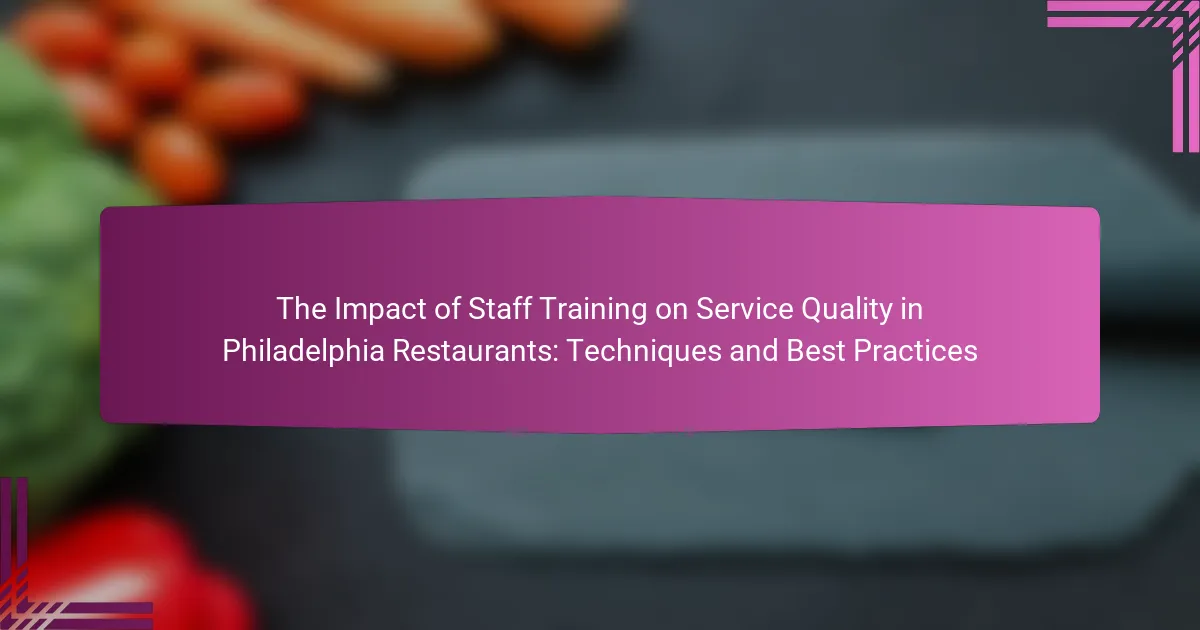
What is the impact of staff training on service quality in Philadelphia restaurants?
Staff training significantly enhances service quality in Philadelphia restaurants. Trained staff are more knowledgeable about menu items and customer service protocols. This expertise leads to improved customer satisfaction and repeat business. A study by the National Restaurant Association found that 70% of customers prefer dining at establishments with well-trained staff. Additionally, effective training reduces employee turnover, creating a more stable workforce. Consistency in service quality is achieved through regular training updates. Overall, investment in staff training correlates with higher service ratings and positive reviews.
How does staff training influence customer satisfaction?
Staff training significantly influences customer satisfaction by enhancing service quality. Well-trained staff are more knowledgeable about products and services. This knowledge allows them to assist customers effectively. They can address inquiries and resolve issues promptly. Research shows that 70% of customer experiences are based on how employees treat them. Training improves communication skills, leading to better interactions. Employees who are confident in their roles provide a more positive experience. A study by the American Society for Training and Development found that companies with comprehensive training programs have 218% higher income per employee. This correlation highlights the direct impact of staff training on customer satisfaction.
What are the key elements of effective staff training programs?
Effective staff training programs include clear objectives, engaging content, skilled trainers, and ongoing assessments. Clear objectives provide direction and ensure training aligns with business goals. Engaging content keeps staff motivated and enhances learning retention. Skilled trainers facilitate knowledge transfer and provide support. Ongoing assessments measure progress and identify areas for improvement. Research shows that effective training can increase employee performance by up to 50%, directly impacting service quality in restaurants.
How can training improve communication skills among restaurant staff?
Training enhances communication skills among restaurant staff by providing structured learning experiences. It equips employees with specific techniques for effective verbal and non-verbal communication. Role-playing scenarios during training can simulate real-life interactions with customers. This practice helps staff gain confidence in their communication abilities. Additionally, training fosters a better understanding of team dynamics and collaboration. Employees learn to listen actively and respond appropriately to customer needs. Research shows that well-trained staff can improve customer satisfaction ratings significantly. For instance, a study by the National Restaurant Association found that effective communication directly correlates with higher service quality scores.
Why is service quality critical in the restaurant industry?
Service quality is critical in the restaurant industry because it directly influences customer satisfaction and loyalty. High service quality enhances the dining experience, leading to repeat business. According to a study by the National Restaurant Association, 70% of customers return to a restaurant primarily due to positive service experiences. Additionally, excellent service can differentiate a restaurant from its competitors in a crowded market. Poor service, on the other hand, can result in negative reviews and loss of customers. Research indicates that 86% of consumers are willing to pay more for a better customer experience. Therefore, maintaining high service quality is essential for profitability and long-term success in the restaurant sector.
What factors contribute to high service quality in restaurants?
High service quality in restaurants is influenced by several key factors. Staff training is crucial as it equips employees with the necessary skills and knowledge. A well-trained staff can provide better customer service and enhance the dining experience. Consistency in service delivery is another important factor. Customers expect the same level of service every time they visit. Effective communication between staff members also plays a vital role. It ensures that orders are taken accurately and customers’ needs are met promptly.
Additionally, restaurant ambiance contributes to service quality. A pleasant environment can enhance customer satisfaction. Customer feedback mechanisms are essential for continuous improvement. Restaurants that actively seek and respond to feedback can refine their service quality. Finally, management support is critical. Strong leadership can foster a culture of excellence in service delivery.
How do customers perceive service quality in dining experiences?
Customers perceive service quality in dining experiences primarily through their interactions with staff. Key factors include attentiveness, responsiveness, and friendliness of the service personnel. Customers expect prompt service and clear communication regarding menu items. Cleanliness of the dining area also plays a significant role in their perception. Research indicates that 70% of diners consider service quality as crucial to their overall satisfaction. Moreover, well-trained staff can enhance the dining experience, leading to positive reviews and repeat visits. Such training often focuses on improving interpersonal skills and efficient service techniques.
What techniques are commonly used in staff training for restaurants?
Common techniques used in staff training for restaurants include on-the-job training, role-playing, and e-learning modules. On-the-job training allows new employees to learn through practical experience alongside seasoned staff. Role-playing helps staff practice customer interactions in a controlled environment. E-learning modules provide flexible, self-paced training on various topics. Additionally, workshops and seminars are utilized for skill enhancement. These methods improve service quality by ensuring staff are well-prepared for real-world scenarios. Research indicates that effective training leads to higher customer satisfaction and retention rates in the restaurant industry.
How can role-playing be utilized in training sessions?
Role-playing can be utilized in training sessions to simulate real-life scenarios. This technique allows participants to practice skills in a controlled environment. It enhances communication and problem-solving abilities among staff. Role-playing encourages active participation and engagement during training. Research indicates that experiential learning methods, like role-playing, improve retention of information. For instance, a study by Kolb (1984) emphasizes the effectiveness of experiential learning in skill development. By acting out situations, employees gain confidence in their roles. This method can lead to improved service quality in restaurants.
What are the benefits of hands-on training in a restaurant setting?
Hands-on training in a restaurant setting enhances practical skills and improves service quality. It allows staff to learn in real-time, fostering confidence in their abilities. This type of training helps employees understand their roles better, resulting in increased efficiency. Research shows that restaurants implementing hands-on training see a 20% increase in customer satisfaction scores. Additionally, hands-on training encourages teamwork and communication among staff, leading to a more cohesive work environment. It also reduces staff turnover by making employees feel more competent and valued. Overall, hands-on training is crucial for developing skilled and motivated restaurant staff.
How can best practices enhance the effectiveness of staff training?
Best practices enhance the effectiveness of staff training by providing structured and proven methods for learning. These practices include clear objectives, relevant content, and interactive training techniques. When training is aligned with specific goals, employees can focus on what is essential for their roles. Engaging training methods, such as role-playing and simulations, improve retention and application of skills. Regular feedback during training sessions helps employees adjust and improve their performance. According to research by the Association for Talent Development, organizations that implement best practices in training see a 218% higher income per employee. This demonstrates that effective training directly correlates with enhanced service quality in restaurants.
What are some successful case studies of training programs in Philadelphia restaurants?
Some successful case studies of training programs in Philadelphia restaurants include the training initiatives at Zahav and Fork. Zahav implemented a comprehensive onboarding program focusing on Israeli cuisine and hospitality standards. This program significantly improved staff knowledge and customer service, leading to higher customer satisfaction ratings. Fork adopted a mentorship model, pairing new hires with experienced staff. This approach enhanced skill development and team cohesion, resulting in improved service efficiency. Both restaurants reported increased repeat business and positive reviews following the implementation of these training programs.
How can restaurants measure the success of their training initiatives?
Restaurants can measure the success of their training initiatives through various metrics. One effective method is to track employee performance before and after training sessions. This can be done using performance reviews and customer feedback. Customer satisfaction scores can provide insight into service quality improvements.
Additionally, monitoring staff retention rates can indicate the effectiveness of training. A decrease in turnover often correlates with better training programs. Training assessments and quizzes can also evaluate knowledge retention among staff.
Finally, analyzing sales data before and after training can reveal the impact on revenue. A notable increase in sales may suggest improved service quality resulting from effective training.
What challenges do restaurants face when implementing staff training?
Restaurants face several challenges when implementing staff training. One major challenge is time constraints. Many restaurants operate with limited staff, making it difficult to allocate time for training without disrupting service. Another challenge is the high turnover rate in the industry. Frequent staff changes can hinder the effectiveness of training programs. Additionally, varying levels of experience among employees can complicate training efforts. Some staff may require more comprehensive training than others, leading to inconsistencies in service quality. Budget limitations can also pose a challenge. Many restaurants struggle to invest in quality training programs due to financial constraints. Furthermore, resistance to change from existing staff can impede the implementation of new training initiatives. Overall, these challenges can significantly affect the success of staff training in restaurants.
How can restaurants overcome resistance to training among staff?
Restaurants can overcome resistance to training among staff by fostering a culture of open communication. Engaging employees in discussions about the benefits of training can enhance their willingness to participate. Providing incentives for completion of training programs can also motivate staff. Incorporating feedback from employees into training content makes it more relevant and appealing. Additionally, offering flexible training schedules can accommodate staff availability, reducing resistance. Research shows that 70% of employees prefer training that aligns with their job responsibilities. This alignment increases engagement and reduces pushback.
What resources are available for restaurants to improve their training programs?
Restaurants can utilize various resources to enhance their training programs. Online training platforms like ServSafe and RestaurantOwner.com offer structured courses. Industry associations such as the National Restaurant Association provide training materials and certifications. Local culinary schools may collaborate with restaurants for tailored training solutions. Additionally, mentorship programs can pair experienced staff with new hires for hands-on learning. Access to training videos and webinars can also facilitate skill development. These resources collectively improve staff performance and service quality in restaurants.
What practical tips can restaurants follow to optimize staff training and service quality?
Restaurants can optimize staff training and service quality by implementing structured training programs. These programs should include both theoretical knowledge and practical skills. Regularly updating training materials ensures staff are informed about new menu items and service protocols. Role-playing scenarios can enhance customer interaction skills. Feedback sessions after service shifts help identify areas for improvement. Monitoring service metrics, such as customer satisfaction scores, provides data for training adjustments. Investing in technology, like training software, streamlines the onboarding process. Creating a positive work environment encourages staff retention and engagement. These strategies collectively lead to improved service quality and customer satisfaction.
The main entity of this article is staff training in Philadelphia restaurants, specifically its impact on service quality. The article outlines how effective staff training enhances customer satisfaction, reduces employee turnover, and improves overall service ratings. Key elements of successful training programs, including techniques like role-playing and hands-on training, are discussed alongside the challenges restaurants face in implementation. Additionally, it highlights the importance of measuring training success and offers practical tips for optimizing training efforts to achieve higher service quality and customer loyalty.



